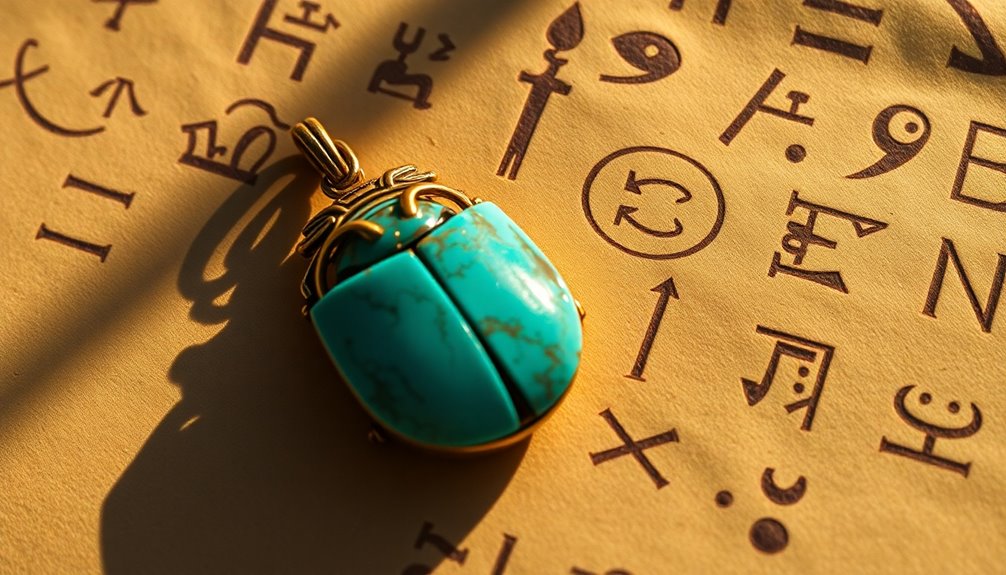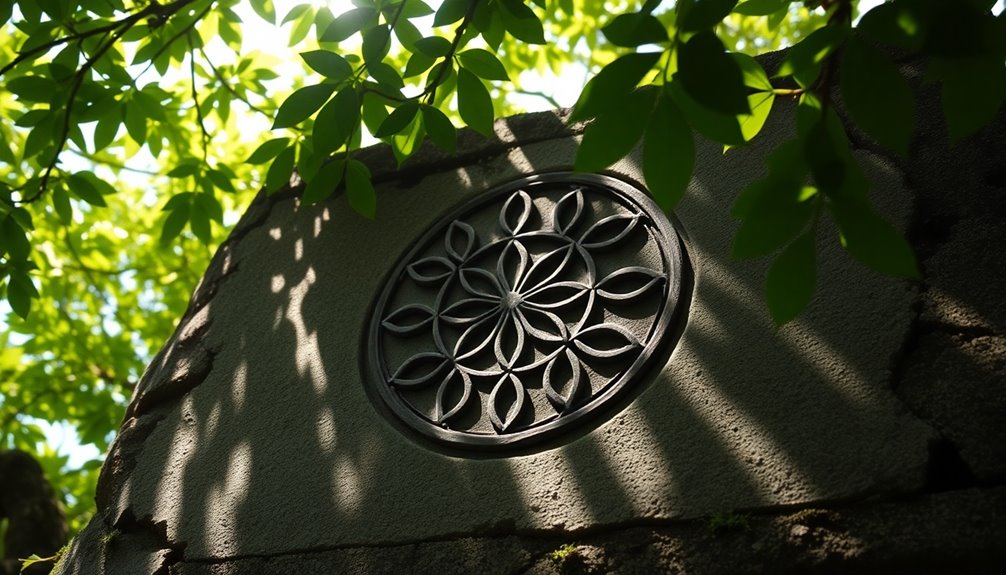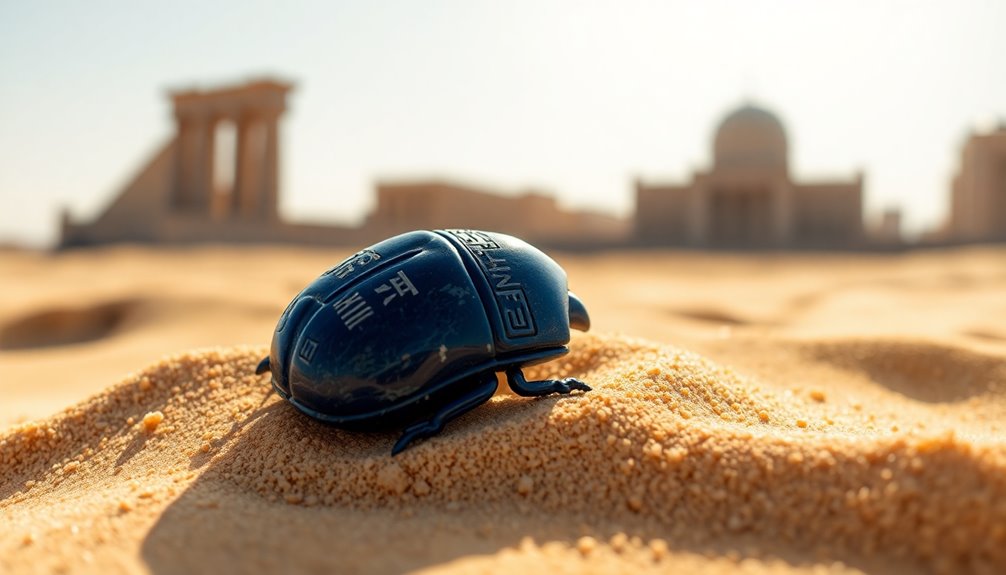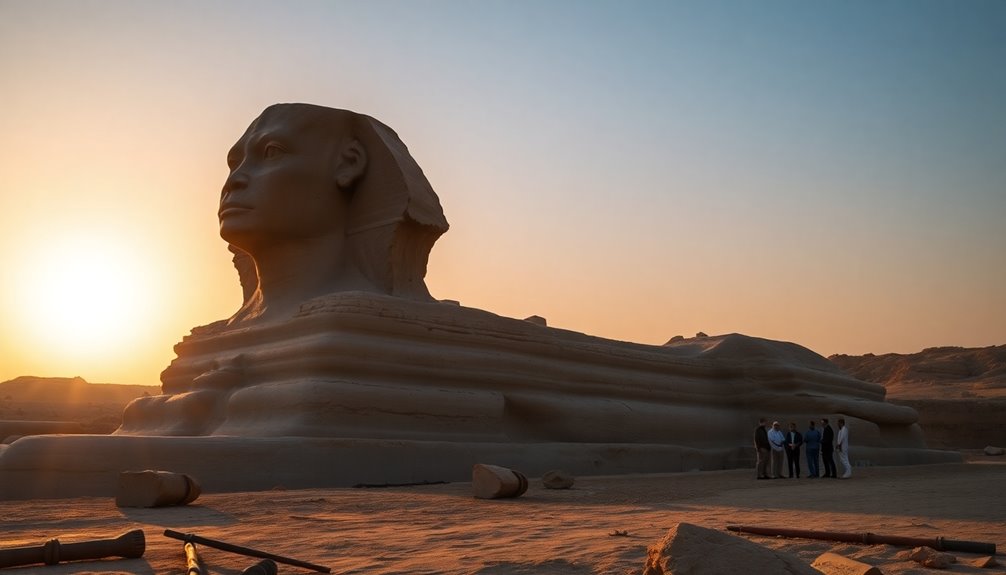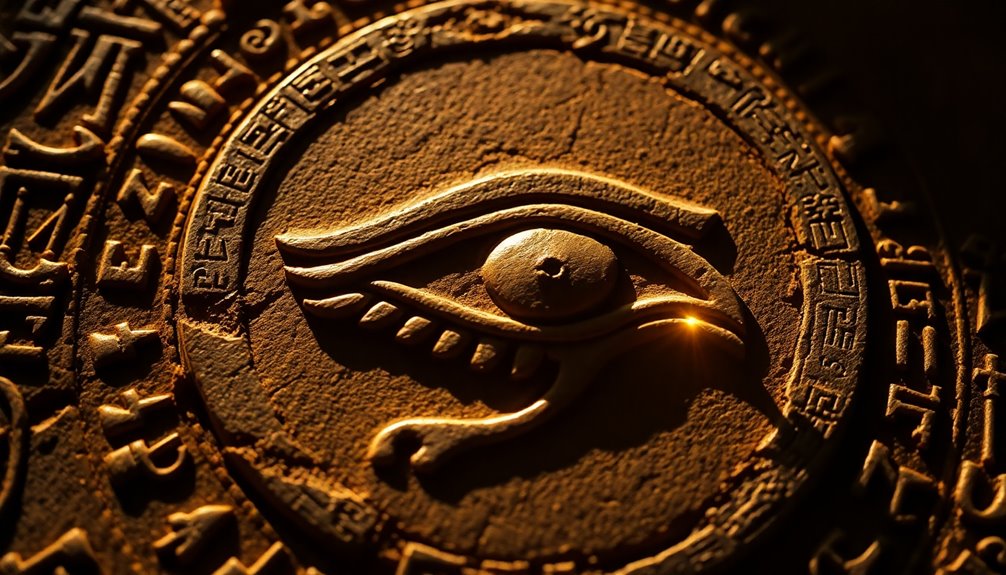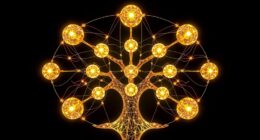Scarabs symbolize life, death, and rebirth in ancient Egyptian culture. They're tied to the sun god Khepri, representing the natural cycles of creation and transformation. Found in tombs, scarabs served as protective amulets, guiding the deceased through the afterlife. Various types, like funerary and heart scarabs, were made from materials such as stone and faience, each with unique inscriptions that reveal social status and trade significance. Their enduring legacy continues to influence modern culture and art. If you're curious about how these ancient symbols connect to current beliefs and practices, there's much more to uncover.
Key Takeaways
- Scarabs symbolize life, death, and the afterlife in ancient Egypt, representing the sun god Khepri and the cycle of rebirth.
- Funerary scarabs were placed in tombs to protect the deceased and symbolize resurrection, reflecting ancient beliefs in transformation.
- Scarabs served as amulets inscribed with spells for protection during the judgment of the soul, linking them to divine guidance.
- Trade and cultural exchanges involving scarabs reveal their significance in ancient Egyptian society, showcasing wealth and social status.
- Modern interpretations of scarabs often misrepresent their historical significance, focusing on myths rather than their cultural and religious importance.
Historical Significance of Scarabs
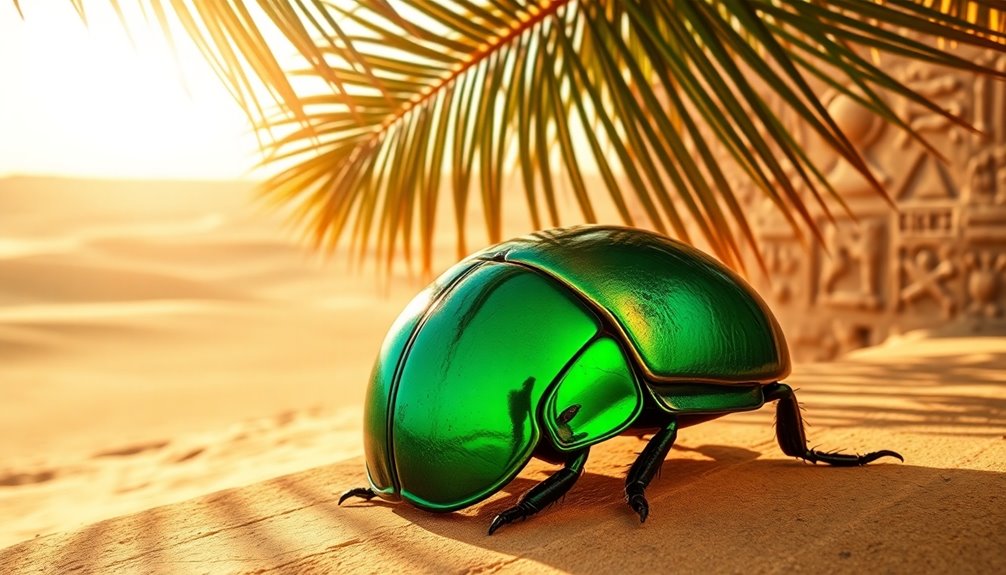
When you investigate the historical significance of scarabs in ancient Egypt, you uncover their deep-rooted connection to life, death, and the afterlife. The scarab beetle, known scientifically as Scarabaeus sacer, was revered for its unique behavior of rolling dung balls, which symbolized the cycles of life and creation associated with the sun god Khepri. This connection made scarabs central to ancient Egyptian religion and culture.
Scarabs gained prominence as funerary practices evolved, particularly by the Middle Kingdom. Thousands of scarabs have been unearthed in Egyptian tombs, often inscribed with names, titles, or prayers for the deceased.
These inscriptions highlight their significance in rituals meant to guarantee a safe passage to the afterlife. Scarabs were commonly placed in tombs as protective amulets, symbolizing resurrection and transformation, reassuring the deceased of their rebirth.
Types and Materials of Scarabs
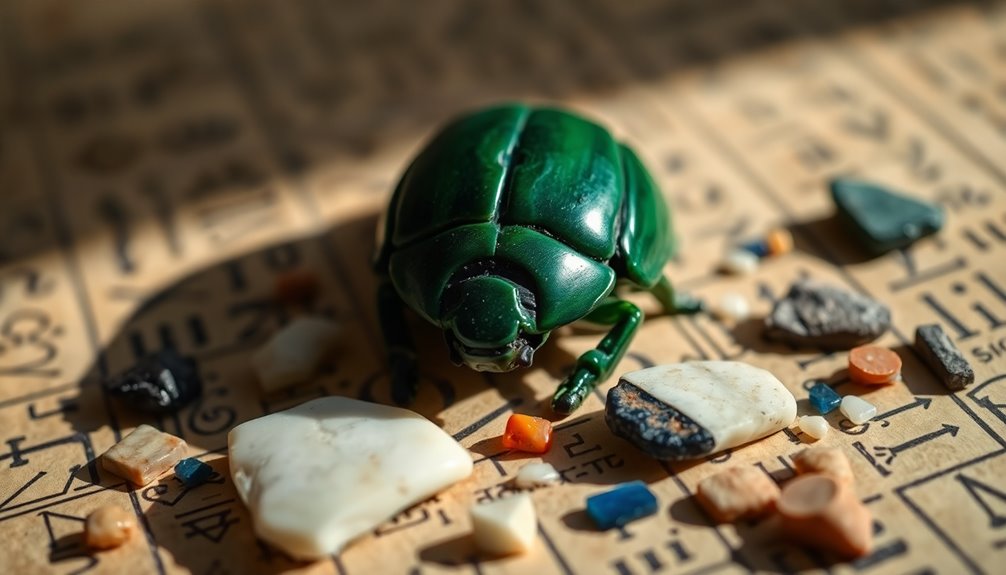
Scarab amulets come in various types and materials, showcasing the artistry and beliefs of ancient Egyptian culture. The craftsmanship of ancient artisans is evident in the diverse materials used, such as stone, glazed blue or green Egyptian faience, and hardstones like green jasper, amethyst, and carnelian.
Common types include:
- Funerary scarabs: Placed in tombs for protection and good luck.
- Heart scarabs: Inscribed with spells from the Book of the Dead to safeguard the deceased during judgment.
- Pectoral scarabs: Large and flat, often associated with the sun god Khepri, sewn onto mummies.
- Commemorative scarabs: Commissioned by pharaohs to celebrate significant events.
- Size variations: Ranging from 6 mm to 40 mm, with common sizes between 10 mm and 20 mm.
Each type reflects unique aspects of the Egyptian civilization, emphasizing both spiritual beliefs and the importance of the afterlife.
Whether as protective charms or symbols of significant events, the variety of scarabs and their materials reveal much about ancient Egyptian culture and craftsmanship.
Symbolism in Ancient Religion
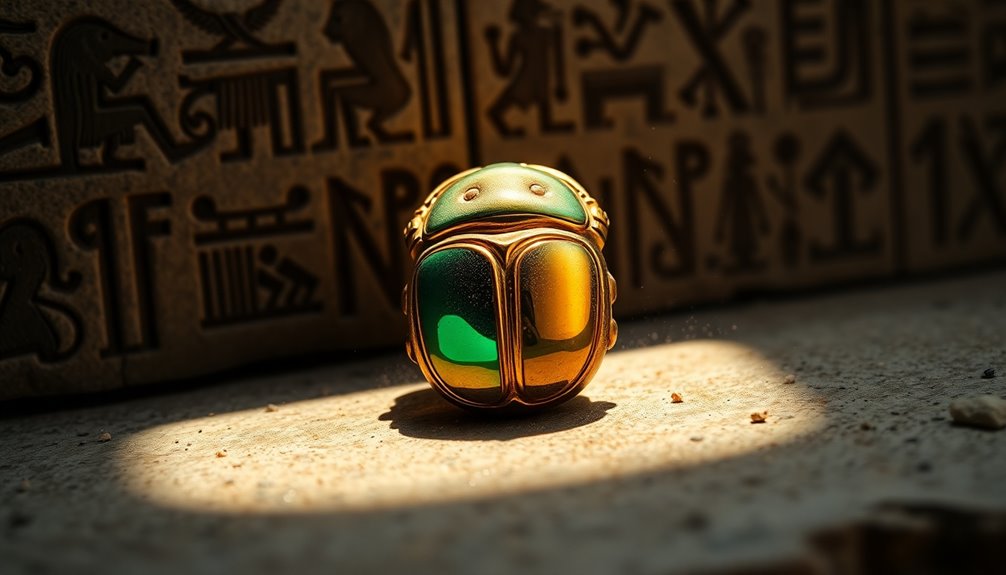
When you explore the symbolism of scarabs in ancient Egyptian religion, you'll find that they represent profound beliefs about resurrection and transformation.
Linked closely to Khepri, the sun god, these beetles embody the daily rebirth of the sun and the cycle of life.
Additionally, scarabs played an essential role in funerary practices, providing protection for the deceased on their journey to the afterlife.
Scarabs and Resurrection Beliefs
Symbolizing resurrection and transformation, scarabs held a profound significance in ancient Egyptian religion. These iconic beetles were closely associated with the sun god Ra and the deity Khepri, representing the cycle of life, death, and rebirth. In funerary practices, scarabs played an essential role in ensuring the deceased's safe passage into the afterlife.
- Heart scarabs were placed on mummies to protect the heart during judgment.
- Inscribed with prayers, scarabs served as amulets for protection and good fortune.
- The dung-rolling behavior of scarabs mirrored the natural cycle of regeneration.
- Scarabs were commonly found in tombs, emphasizing their connection to immortality.
- Thousands of scarabs have been unearthed, showcasing their importance in ancient Egyptian culture.
For the ancient Egyptians, scarabs embodied the hope for resurrection and eternal life. By incorporating these symbols into their burial rituals, they sought to safeguard their journey into the afterlife, relying on the transformative power that scarabs represented. Furthermore, their role as protective amulets further illustrates how deeply intertwined they were with beliefs surrounding the afterlife.
Consequently, scarabs weren't just mere artifacts; they were essential links to the beliefs surrounding immortality and spiritual continuity.
Khepri: Sun God Symbol
Khepri, an important aspect of the sun god Ra, embodies the transformative power of creation and renewal in ancient Egyptian religion. Represented as a scarab beetle, Khepri symbolizes the sun's journey across the sky each day. Ancient Egyptians believed that just as the scarab rolls dung balls, Khepri rolls the sun across the horizon at dawn, marking the start of a new day and the cycle of life.
The name Khepri comes from the Egyptian word "kheper," meaning "to come into being" or "to transform," highlighting the scarab's association with rebirth. Scarabs inscribed with prayers and spells dedicated to Khepri were often placed in tombs, serving as protective talismans for the deceased. These offerings were meant to guarantee their safe passage and rebirth in the afterlife.
Khepri's significance extends beyond mere symbolism; it emphasizes the cyclical nature of existence. By linking the scarab beetle to themes of resurrection and eternal life, ancient Egyptians created a powerful narrative around the sun god Khepri, reinforcing their beliefs in the interconnectedness of life, death, and rebirth.
Protection in Funerary Practices
Ancient Egyptians intricately wove scarabs into their funerary practices, believing these symbols provided essential protection for the deceased. Funerary scarabs, often placed in tombs, were more than mere artifacts; they embodied the hope for resurrection and immortality.
By placing scarab beetles in tombs, the ancient Egyptians sought to guarantee safe passage to the afterlife.
- Heart scarabs: Inscribed with spells from the Book of the Dead, they protected the heart during judgment by Osiris.
- Material significance: Funerary scarabs were made from stone or faience, linking the deceased to divine protection.
- Symbolism of rebirth: Scarabs represented the sun god Ra and Khepri, highlighting transformation and the cyclical nature of life and death.
- Good luck charms: Beyond protection, scarabs served as amulets for the living, showcasing their dual significance.
- Divine manifestation: Their presence in tombs was a way to invoke divine favor for the deceased in the afterlife.
Through these practices, scarabs emerged as powerful symbols of protection, guaranteeing that the spirits of the departed navigated the afterlife safely and securely.
Scarabs in Funerary Practices
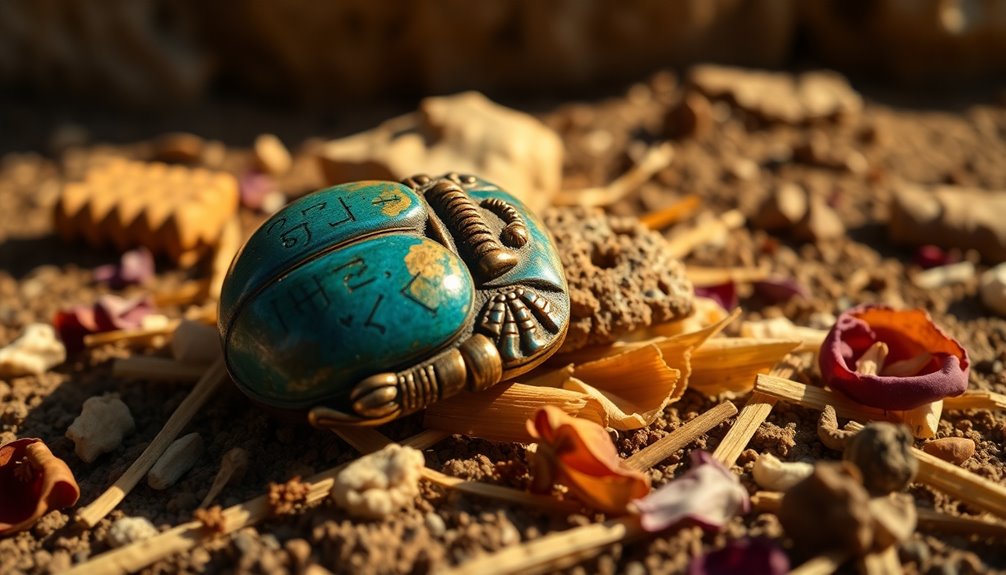
Scarabs played a vital role in funerary practices, especially heart scarabs that were often placed on mummies or within tombs. These sacred symbols provided protection and aided the deceased during their judgment in the afterlife, invoking spells from the Book of the Dead.
| Aspect | Details |
|---|---|
| Heart Scarabs | Placed on mummies for protection during judgment |
| Inscription | Names or prayers to serve as personal amulets |
| Symbolism | Represents resurrection and transformation |
| Tomb Architecture | Decorative elements guaranteeing safe passage |
Scarabs were not just decorative; they were essential amulets believed to guarantee safety and good fortune. During mummification, scarab amulets were placed directly on the heart, reflecting its vital role in the afterlife. Egyptians believed the heart would be weighed against the feather of Ma'at, determining the deceased's fate.
The symbolic meaning of scarabs linked to the eternal cycle of life, death, and rebirth made them invaluable in funerary rituals. Their presence in tombs and burial sites emphasized their purpose: to protect the deceased and facilitate a successful journey into the afterlife.
Trade and Cultural Exchange
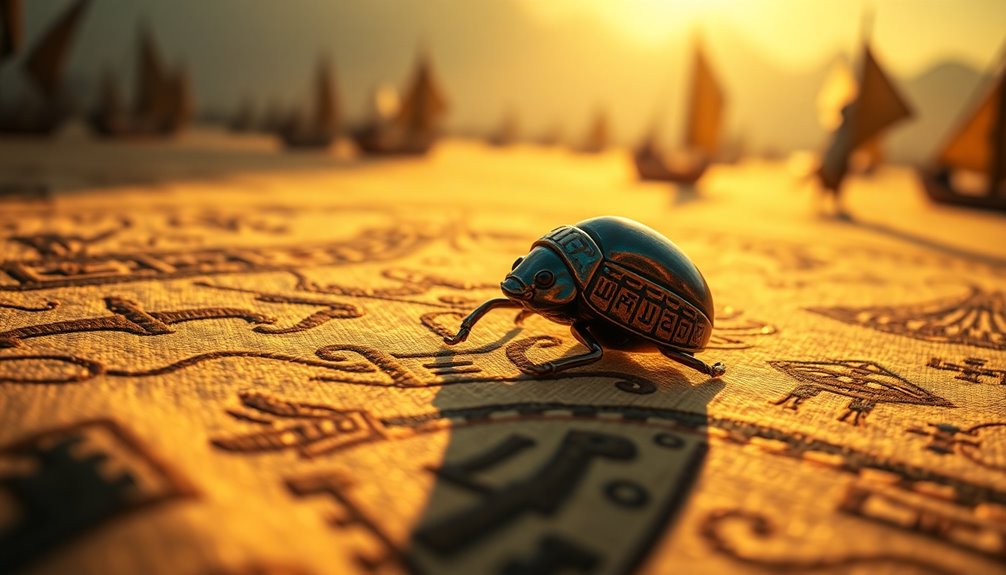
The significance of scarabs extended beyond funerary practices, as they became essential tools in trade and cultural exchange. During the Middle Bronze Age, ancient Egyptians not only produced scarabs but also traded them extensively, importing designs and materials from the Mediterranean and the Middle East.
These intricate artifacts provided valuable insights into the trade networks linking Egypt with neighboring cultures.
- Unique inscriptions reveal connections between ancient Egyptian and other civilizations.
- Canaanite artisans imitated scarab designs, blending new decorative elements.
- During the Achaemenid Empire, Phoenicians assimilated scarab motifs, integrating them into their culture.
- Scarabs served as amulets and seals, enhancing their significance in trade relationships.
- They indicated social status, showcasing wealth and influence in ancient society.
These interactions highlight the role of scarabs not just as symbols of protection but as integral components of economic and cultural exchanges.
Scarabs in Modern Culture

Throughout modern culture, scarabs have taken on various roles, enchanting audiences and inspiring creativity. These ancient Egyptian symbols are often associated with protection and transformation, reflecting their rich cultural significance.
| Medium | Scarabs' Role |
|---|---|
| Film | Depicted as dangerous creatures in "The Mummy," shaping perceptions of ancient Egyptian symbolism. |
| Music | Journey's logo features scarab imagery, showcasing their enduring influence in rock culture. |
| Jewelry Design | Art Nouveau pieces from the early 1900s highlight scarab motifs, blending history with aesthetic appeal. |
Scarabs continue to thrive in contemporary art, representing adventure and ancient mysteries in video games like "Tomb Raider" and "Dungeons and Dragons." Their enduring presence reflects not just a fascination with the past but also a deep connection to ancient spiritual beliefs. This timeless symbol transcends epochs, reminding us of the rich tapestry of history and the ongoing dialogue between the past and present. As you explore modern culture, keep an eye out for these enchanting symbols that evoke the allure of ancient Egypt.
Frequently Asked Questions
What Is the Scarab in Egyptian Burial?
In Egyptian burial practices, the scarab symbolizes protection and rebirth. You'd find these amulets placed in tombs, ensuring safe passage to the afterlife for the deceased.
Heart scarabs, inscribed with spells, were positioned near the heart during mummification to safeguard the soul during judgment.
These artifacts not only reflected the individual's status but also played an essential role in funerary rituals, emphasizing transformation and the journey beyond death.
Why Did the Ancient Egyptians Bury Their Dead With the Scarab Amulet Over Their Hearts?
Imagine your heart wrapped in a protective embrace; that's what ancient Egyptians aimed for with scarab amulets.
They buried their dead with these symbols over the heart to guarantee safe passage to the afterlife. Scarabs represented resurrection, guarding the soul during judgment.
Inscribed with spells from the Book of the Dead, these amulets weighed the heart against Ma'at's feather, reflecting the belief in moral integrity and the hope for eternal life.
What Is the Spiritual Meaning of the Egyptian Scarab?
The spiritual meaning of the Egyptian scarab revolves around transformation and rebirth.
When you think of the scarab, you can visualize its role in symbolizing the cycle of life and the journey to the afterlife.
It represents protection and good fortune, guiding souls through spiritual changes.
As you explore this symbol, you'll discover its deep connections to the sun god Ra and the eternal quest for immortality in ancient Egyptian beliefs.
What Is the Spiritual Meaning of the Dead Scarab?
When you think of the dead scarab, it's a gentle reminder of life's cycle.
This symbol of transformation and resurrection embodies the journey from existence to the afterlife.
You'll find that ancient Egyptians placed scarabs on mummies, believing they'd protect souls during their passage.
Conclusion
In exploring the rich tapestry of scarabs, you've uncovered their profound historical significance and enduring symbolism. These ancient artifacts not only adorned the tombs of pharaohs but also connected diverse cultures through trade. As you reflect on the legacy of scarabs, consider this: what secrets might these small beetles still hold for us today? Their journey from ancient Egypt to modern times reminds us of the timeless stories embedded within our own history, waiting to be discovered.

